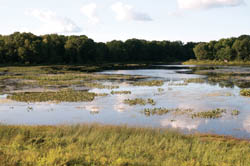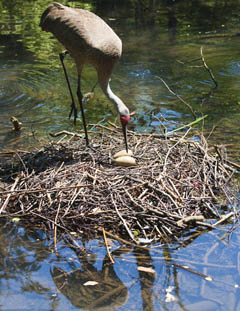Editor’s note
Twenty-nine years ago, John Baden and Rick Stroup wrote “Saving the Wilderness,” published by Reason magazine in July 1981. The article focused on management of the Paul J. Rainey Preserve in Louisiana, which is owned by the National Audubon Society. Patrick Cox, then a free-lance writer working for Reason, provided on-the-ground support at the Preserve, and wrote the moving descriptions of the wildlife and natural beauty there that open the article. “The sun through morning fog is the signal for thousands of snow geese to prepare for flight. On some mornings the sky may fill with…60,000 geese in the air, blanketing normal conversation. When the morning flight ends in the Rainey Wildlife Sanctuary, a visitor may decide to take the long way home and see more….The Cajun guide can bring you to man-made islands of steel and concrete: natural gas wells.”
The authors went on to ask: “Gas wells in terrain managed by professional, dedicated environmentalists may seem almost as out of place as free drinks at an AA meeting. What happened to the hostility that has come to exist between resource developers and conservationists? Have the lion and the lamb laid down together in the same field?” Did this recognition that marketing goods and services can be compatible with the protection of environmental amenities spread beyond Rainey?
“Saving the Wilderness” explained how the managers of the Rainey Preserve used market relationships to enhance private land management and how they and similar managers could, if allowed, improve the management of government land, too. The institutional rules, though, would have to be rewritten just enough to allow managers to trade rights when doing so would, in their judgment, enhance the values for which the land had been politically set aside. Essentially, we wanted to show that the protection of wilderness— an area where the earth and its community of life are untrammeled by man, where man himself is a visitor who does not remain, to quote the words of the Wilderness Act of 1964—could be reconciled through markets with the benefits that come from using minerals.
In 1980, Ronald Reagan had been elected President of the United States, and early in his administration he had announced his intention to change the management of federal lands to provide more access for mineral development on those lands. There was nothing inherently radical about this. Many federal holdings were already managed for “multiple use” (e.g., to provide natural preservation, public recreation, and commodity production, such as logging and mining). There was also increasing pressure for mining, especially for minerals that had strategic value to the national defense mission of the government. At the same time, opponents of mineral development were many, with environmental groups chief among them. They argued that the very concept of wilderness is not compatible with mineral mining or drilling. They demanded that such activities be strictly banned on lands set aside as wilderness as well as on lands that had been designated as Wilderness Study Areas. Whose values would rule? And where? Each side wanted it all, but only one side could win under the existing policy. The conduct of land use management by the federal government had become filled with acrimony.
The sensible management of the Rainey Preserve, and the constructive interactions of oil and gas developers with the Audubon managers of the Preserve, in contrast, provided a model for us to describe how competing values can both be enhanced if, and when, market forces are allowed to work. We believed that the same could happen in the federal land management agencies, even on lands designated for wilderness management.
Audubon Meets Oil Companies
Rainey had been set aside as a wildlife refuge in 1924. When natural gas was discovered near the Preserve around 1940, oil companies expressed an interest in drilling on the refuge. Audubon at first declined, I was told, but did agree to meet with oil company biologists to lay out its goals and explain why drilling was not consistent with those goals. As the biologists exchanged ideas over time, and worked with geologists to develop a drilling plan to use new drilling technologies, seasonal limits, and other restrictions, the oil companies and Audubon found common ground and entered into agreements.
Could the same ideas work on federal lands already set aside? We set out to show that they could. The federal acreage at stake is very large and potentially the source for both minerals and wilderness services—that is, the protection of wildlife and the natural environment that was desired by the Audubon managers of the Rainey. A concept like the one operating at Rainey could make minerals much more available to the nation and, by making wilderness management more compatible with mineral production, could lower the cost of managing more lands for wilderness values.

Mr. Stroup Goes to Washington
My own views were less negative, however, so in 1982 I took a temporary assignment working for Secretary Watt at the Department of Interior. I had no illusions of being able to bring great changes on my own, but if our ideas had force, then why not see what could be done? I might be able to “sell” some PERC ideas, such as the cooperation between Audubon and oil companies that occurred on private land. In any case, I knew that I would learn a lot as Director of the Office of Policy Analysis, in the Office of the Secretary. I was put in charge of 40 very smart, hard-working professionals, who knew far more than I about the specific bureau that each followed and about the narrow specialty that each had mastered.
The first thing the staff taught me was that while we economists cherish and work for economic efficiency, the blunt fact of Washington, D.C., is that efficiency has no politically organized constituency. None! Yet to be elected, a politician needs the help of many constituencies, each willing to provide support, especially at election time. My response to this problem was this: Our job in providing policy advice to the Office of the Secretary was to tie efficiency to the generation of support for the president’s policies, since every political appointee, including the interior secretary, serves at the pleasure of the president. If the policy we recommended was efficient, then the added productivity that would come about could be harnessed to generate political support. If we wanted an effective option, our job was to make it pay political dividends in an economical way.

The New Rainey Preserve
For nearly 50 years, the Audubon Society allowed an oil company to operate 13 wells in the sanctuary. The company had to comply with strict stipulations such as no pumping during the nesting season. In exchange, Audubon earned more than $25 million and was able to buy additional land for conservation with its profits. It appears now that Audubon’s Bernard Baker Sanctuary in Michigan is following in Rainey’s footsteps. In this case, the oil well was placed on private property bordering the preserve with a drill that slants into the sanctuary’s reserves. Terry Anderson and Laura Huggins interviewed Mike Boyce, Bernard’s resident manager, for their book Greener Than Thou. Boyce claimed the agreement earned $500,000 for Audubon and that Baker is in negotiations with another company and private landowner to build an oil rig on the other side of the Sanctuary. Audubon is smart to maintain wildlife habitat while capitalizing on revenue potential—now if only our federal land management agencies could figure this out.





